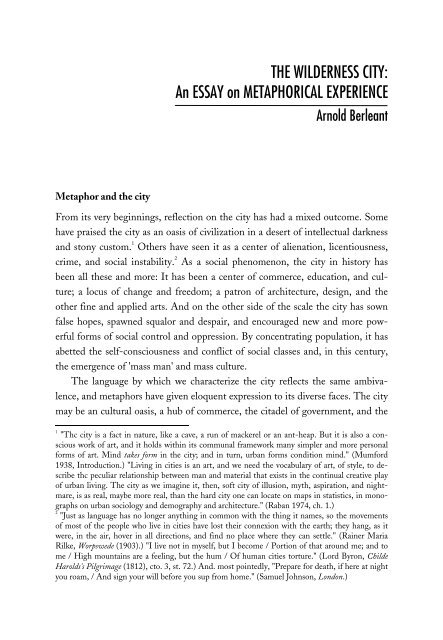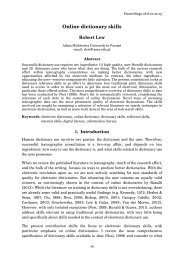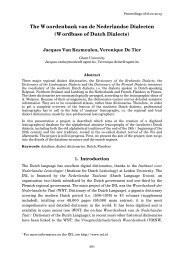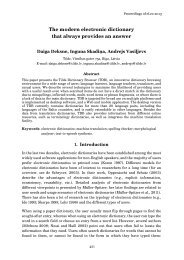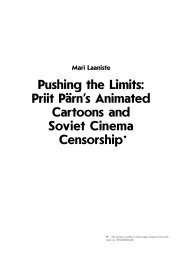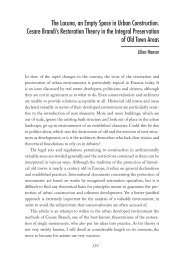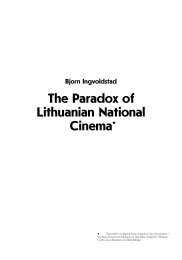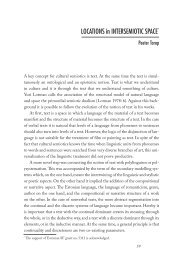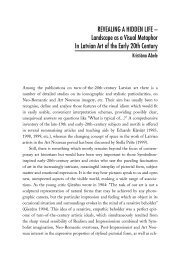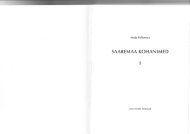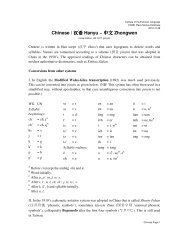THE WILDERNESS CITY: An ESSAY on METAPHORICAL ...
THE WILDERNESS CITY: An ESSAY on METAPHORICAL ...
THE WILDERNESS CITY: An ESSAY on METAPHORICAL ...
You also want an ePaper? Increase the reach of your titles
YUMPU automatically turns print PDFs into web optimized ePapers that Google loves.
Metaphor and the city<br />
<str<strong>on</strong>g>THE</str<strong>on</strong>g> <str<strong>on</strong>g>WILDERNESS</str<strong>on</strong>g> <str<strong>on</strong>g>CITY</str<strong>on</strong>g>:<br />
<str<strong>on</strong>g>An</str<strong>on</strong>g> <str<strong>on</strong>g>ESSAY</str<strong>on</strong>g> <strong>on</strong> <strong>METAPHORICAL</strong> EXPERIENCE<br />
Arnold Berleant<br />
From its very beginnings, reflecti<strong>on</strong> <strong>on</strong> the city has had a mixed outcome. Some<br />
have praised the city as an oasis of civilizati<strong>on</strong> in a desert of intellectual darkness<br />
and st<strong>on</strong>y custom. 1<br />
Others have seen it as a center of alienati<strong>on</strong>, licentiousness,<br />
crime, and social instability. 2 As a social phenomen<strong>on</strong>, the city in history has<br />
been all these and more: It has been a center of commerce, educati<strong>on</strong>, and culture;<br />
a locus of change and freedom; a patr<strong>on</strong> of architecture, design, and the<br />
other fine and applied arts. <str<strong>on</strong>g>An</str<strong>on</strong>g>d <strong>on</strong> the other side of the scale the city has sown<br />
false hopes, spawned squalor and despair, and encouraged new and more powerful<br />
forms of social c<strong>on</strong>trol and oppressi<strong>on</strong>. By c<strong>on</strong>centrating populati<strong>on</strong>, it has<br />
abetted the self-c<strong>on</strong>sciousness and c<strong>on</strong>flict of social classes and, in this century,<br />
the emergence of 'mass man' and mass culture.<br />
The language by which we characterize the city reflects the same ambivalence,<br />
and metaphors have given eloquent expressi<strong>on</strong> to its diverse faces. The city<br />
may be an cultural oasis, a hub of commerce, the citadel of government, and the<br />
1 "Thc city is a fact in nature, like a cave, a run of mackerel or an ant-heap. But it is also a c<strong>on</strong>scious<br />
work of art, and it holds within its communal framework many simpler and more pers<strong>on</strong>al<br />
forms of art. Mind takes form in the city; and in turn, urban forms c<strong>on</strong>diti<strong>on</strong> mind." (Mumford<br />
1938, Introducti<strong>on</strong>.) "Living in cities is an art, and we need the vocabulary of art, of style, to describe<br />
thc peculiar relati<strong>on</strong>ship between man and material that exists in the c<strong>on</strong>tinual creative play<br />
of urban living. The city as we imagine it, then, soft city of illusi<strong>on</strong>, myth, aspirati<strong>on</strong>, and nightmare,<br />
is as real, maybe more real, than the hard city <strong>on</strong>e can locate <strong>on</strong> maps in statistics, in m<strong>on</strong>ographs<br />
<strong>on</strong> urban sociology and demography and architecture." (Raban 1974, ch. 1.)<br />
2 "Just as language has no l<strong>on</strong>ger anything in comm<strong>on</strong> with the thing it names, so the movements<br />
of most of the people who live in cities have lost their c<strong>on</strong>nexi<strong>on</strong> with the earth; they hang, as it<br />
were, in the air, hover in all directi<strong>on</strong>s, and find no place where they can settle." (Rainer Maria<br />
Rilke, Worpswede (1903).) "I live not in myself, but I become / Porti<strong>on</strong> of that around me; and to<br />
me / High mountains are a feeling, but the hum / Of human cities torture." (Lord Byr<strong>on</strong>, Childe<br />
Harolds's Pilgrimage (1812), cto. 3, st. 72.) <str<strong>on</strong>g>An</str<strong>on</strong>g>d. most pointedly, "Prepare for death, if here at night<br />
you roam, / <str<strong>on</strong>g>An</str<strong>on</strong>g>d sign your will before you sup from home." (Samuel Johns<strong>on</strong>, L<strong>on</strong>d<strong>on</strong>.)
29<br />
The Wilderness City<br />
fount of civilizati<strong>on</strong>. No single metaphor for urbanism provides a complete picture<br />
but rather each reflects <strong>on</strong>e facet of a complex phenomen<strong>on</strong>. Some figures<br />
suggest optimistic possibilities and express ideals for urban design. The 'garden<br />
city' c<strong>on</strong>veys a fusi<strong>on</strong> of nature and culture, a cultivated nature in which c<strong>on</strong>trol<br />
takes a quietly benevolent course in promoting the flowering of people's lives in<br />
an Edenic urban setting (Howard 1945, Stein 1957). The 'forest city,' beloved of<br />
Finland's planners, defers to natural imperatives more respectfully, seeing urban<br />
success less in c<strong>on</strong>trolling nature than in envisi<strong>on</strong>ing a harm<strong>on</strong>ious collaborati<strong>on</strong><br />
in which the forest is a benign setting for human habitati<strong>on</strong>. 3 The 'machine city'<br />
reflects the technocratic goal of subjugating nature, imposing the human imprint<br />
<strong>on</strong> the landscape through what Victor Hugo called "the somber sadness of right<br />
angles:" survey grids, street grids, and housing tracts. 4 The 'asphalt jungle' c<strong>on</strong>veys<br />
something of the urban social patterns that emerge in predatory gangs,<br />
gratuitous violence, and the venal exploitati<strong>on</strong> of the weak. 5 To this perhaps Calvino's<br />
'invisible cities' offer an antidote in the regi<strong>on</strong>s of imaginati<strong>on</strong> and fantasy<br />
(Italo Calvino, Invisible Cities, 1974).<br />
All these metaphors are true, for all c<strong>on</strong>vey aspects of urban life and the<br />
multiple c<strong>on</strong>diti<strong>on</strong>s and experiences that cities offer. Each metaphor both captures<br />
and creates a greater understanding of the city. 6 To make such a claim,<br />
however, does not settle the issue but <strong>on</strong>ly raises it anew: For what is metaphor<br />
and how does it functi<strong>on</strong>? Despite the fact that metaphor has been the subject of<br />
philosophic and literary reflecti<strong>on</strong> since classical times, it remains elusive. This is<br />
so even though metaphor is almost as comm<strong>on</strong> a subject of discussi<strong>on</strong> in its own<br />
right as it is an object of use. Perhaps we can best explore the first by examining<br />
3<br />
Munkkiniemi was the earliest of these planned forest communities. Tapiola, later, gained internati<strong>on</strong>al<br />
prominence and was widely imitated.<br />
4<br />
Walter Gropius and the Bauhaus exemplified this aesthetic: "We want an architecture adapted to<br />
our world of machines, radios and fast motor cars, an architecture whose functi<strong>on</strong> is clearly recognizable<br />
in relati<strong>on</strong> of its forms." "Every architect must understand the significance of the city in<br />
order to be able to engage actively in city planning: he must recognize 'simplicity in multiplicity' as a<br />
guiding principle in the shaping of its character. Form elements of typical shape should be repeated<br />
in series." (Gropius 1959: 28, 29.) Frank Lloyd Wright observed that the steel and glass<br />
sky-scraper is a mechanical building, a "machine pure and simple."<br />
5<br />
W. R. Burnett, The Asphalt Jungle, 1949; "The city is not a c<strong>on</strong>crete jungle, it is a human zoo." –<br />
Dem<strong>on</strong>d Morris, The Human Zoo, 1969, Introducti<strong>on</strong>.<br />
6<br />
Carl R. Hausman develops an interacti<strong>on</strong> theory that recognizes the creative functi<strong>on</strong> of metaphor<br />
(Hausman 1989).
Arnold Berleant<br />
the sec<strong>on</strong>d, hoping to grasp something of the special quality of metaphorical<br />
thinking by probing into the way it works in a particular case.<br />
This inquiry into the aesthetic of the city has, therefore, two objectives. One<br />
is to explore the dimensi<strong>on</strong> of urban life suggested by a still different metaphor,<br />
'wilderness,' in the hope of discovering what distinctive visi<strong>on</strong> of urban life the<br />
'wilderness city' can provide. The other is to use this investigati<strong>on</strong> to uncover<br />
something about the meaning and functi<strong>on</strong> of metaphor – more exactly, about<br />
metaphorical experience.<br />
Wilderness as a metaphor for the city<br />
The meaning of 'wilderness' has a l<strong>on</strong>g and varied history. The shift in its c<strong>on</strong>notati<strong>on</strong><br />
from a dark and dangerous place that fills <strong>on</strong>e with foreboding to a<br />
place of adventure, discovery, and even of exhilarati<strong>on</strong> and awe began in earnest<br />
in the West during the eighteenth century. Over the past hundred years, 'wilderness'<br />
has acquired a still more positive c<strong>on</strong>notati<strong>on</strong>, becoming a place to be<br />
valued and protected, and a source of values and of human c<strong>on</strong>necti<strong>on</strong>s with the<br />
rest of the natural world (Rolst<strong>on</strong> 1989: 118–143). When the wilderness metaphor<br />
is applied to urban experience, however, the word reverts to its earlier, forbidding<br />
sense of a trackless domain uninhabited by humans.<br />
Wilderness differs in curious ways from the comparable metaphors of garden<br />
and forest. Unlike these, which c<strong>on</strong>vey human use and cultivati<strong>on</strong>, wilderness is<br />
a dark metaphor. It does not elevate or romanticize the city but relates it instead<br />
to an ominous place, evoking a feeling of apprehensi<strong>on</strong>. The effectiveness of this<br />
metaphor may actually lie in its very obscurity and ambivalence. Working inversely,<br />
it illuminates the city through its very darkness. To the extent that regarding<br />
the city as wilderness tells us something about it that we might not obtain<br />
in other ways, it is useful. To the extent that this metaphor tells us something<br />
about ourselves, it may be even more useful. I find wilderness to have both<br />
such values, and in a rather unexpected way.<br />
Thinking of the city as wilderness leads us in unusual directi<strong>on</strong>s. We may, at<br />
times c<strong>on</strong>sider the city overwhelming and hostile, not a place for preserving and<br />
promoting human values. Its unfamiliarity makes the city appear c<strong>on</strong>fusing,<br />
threatening in its very strangeness. These traits become more recognizable, even<br />
acceptable, when a city's features are seen as analogous to those of a wilderness,<br />
30
31<br />
The Wilderness City<br />
some of them benign, others less so. For example, <strong>on</strong>e can find a parallel between<br />
the momentary respite from immersi<strong>on</strong> in the density of a city or wilderness<br />
either by the panoramic view from the observati<strong>on</strong> deck of a skyscraper or a<br />
broad boulevard, or by the sweeping panorama <strong>on</strong>e might obtain from a mountain<br />
top, bluff, or tall tree. The aroma emanating from a bakery or restaurant<br />
might remind <strong>on</strong>e of the odors of different vegetati<strong>on</strong> or ground surfaces, such as<br />
pine needles or wet soil. The odor of decaying leaves or the effluvium of a marsh<br />
or swamp in the hot sun may resemble the smell of garbage c<strong>on</strong>tainers <strong>on</strong> the<br />
sidewalk awaiting pickup or the exhaust of motor vehicles. Moving am<strong>on</strong>g<br />
buildings and al<strong>on</strong>g streets has some of the perceptual quality of moving am<strong>on</strong>g<br />
stands of trees and through openings in the vegetati<strong>on</strong>. The background hum of<br />
traffic is reminiscent of the wind rushing through the trees when a fr<strong>on</strong>t is<br />
coming through. Pushing <strong>on</strong>e's way through a crowd resembles the experience of<br />
pressing through dense growth. C<strong>on</strong>stant c<strong>on</strong>cern over making a misstep influences<br />
our passage through both city and wilderness, while the background apprehensi<strong>on</strong><br />
of danger from motor vehicles and muggers parallels the c<strong>on</strong>stant<br />
threat, real or imagined, from the deadly creatures thought to inhabit a wilderness.<br />
In both city and wilderness, feeling out of place is a vivid comp<strong>on</strong>ent of the<br />
experience. With familiarity, the wilderness city may change into something<br />
different, such as a park or jungle. The last of these finds comm<strong>on</strong> ground between<br />
tribal warfare and the urban dangers of gang wars. As a metaphor, wilderness<br />
preserves its darkness.<br />
For metaphors embody values. They are judgments just as much when hidden<br />
behind figurative language as when they are displayed openly. When traffic<br />
becomes a torrent and urban crime is endemic, the city is described as a jungle,<br />
the reference being to the threatening features of wild nature. Generally, when<br />
the city is compared with nature, it comes out behind. From Aesop, "Better<br />
beans and bac<strong>on</strong> in peace than cakes and ale in fear," 7 through the seventeenth<br />
and eighteenth centuries, "God the first garden made, and the first city Cain," 8<br />
and "God made the country, and man made the town," 9 the city has often been<br />
regarded as a fearful and dangerous place, to be shunned in favor of the peace<br />
and safety of the countryside. However, when unchanneled nature is tamed into<br />
7 Aesop, "The Town Mouse and the Country Mouse".<br />
8 Abraham Cowley (1618–1667), "Of Solitude", II.<br />
9 William Cowper (1731–1800), "The Task", Bk. I, "The Sofa", 1.749.
Arnold Berleant<br />
a garden, it is no l<strong>on</strong>ger fearsome but a setting for gentle pleasures preferable to<br />
city life.<br />
The wilderness envir<strong>on</strong>ment does not stand apart; it has no <strong>on</strong>tological<br />
status. Nor is it a neutral object. What we understand by wilderness is a cultural<br />
meaning, its significance and associati<strong>on</strong>s hold for the culture in which we participate.<br />
We have noted how the idea of wilderness is historically c<strong>on</strong>diti<strong>on</strong>ed,<br />
changing in the eighteenth century from a wild place haunted by darkness, danger,<br />
and desolati<strong>on</strong>, to <strong>on</strong>e where we can encounter, admire, and enjoy nature.<br />
This transformati<strong>on</strong> in meaning is part of a process that still c<strong>on</strong>tinues, as we<br />
rec<strong>on</strong>figure nature from a threat into a resource, from a source of wealth into a<br />
haven of respite from the pressures of urban life, from a playground into a domain<br />
demanding respect for its own inherent values.<br />
Metaphorical reciprocity<br />
Oddly enough, the metaphorical relati<strong>on</strong> between city and wilderness seems to<br />
work in both directi<strong>on</strong>s. One might think to gain a better understanding of the<br />
city by seeing it as a rec<strong>on</strong>structed, rati<strong>on</strong>alized wilderness, interpreting the city,<br />
that is, through the image of wilderness, even though <strong>on</strong>e somewhat smoothed<br />
over by a coating of civility. If, <strong>on</strong> the other hand, we start with the city, it is easy<br />
to impose our sense of urban experience <strong>on</strong>to the meaning of wilderness, ascribing<br />
to wilderness the fears and dangers we feel in the city. Not without some<br />
reas<strong>on</strong> did Shakespeare characterize Rome as a "wilderness of Tigers," 10 nor has<br />
Rome been the <strong>on</strong>ly city to figure in such descripti<strong>on</strong>s. In this case, the city may<br />
be thought of as a metaphor for our cultural c<strong>on</strong>structi<strong>on</strong> of wilderness. Once we<br />
enter into the metaphor, neither directi<strong>on</strong> for developing metaphorical meaning<br />
seems independent of the other.<br />
What insight does the wilderness metaphor have for the city? Like any<br />
metaphor, it enlarges experience by expanding its c<strong>on</strong>necti<strong>on</strong>s and reference.<br />
The metaphor of wilderness helps us grasp urban experience in a way that is<br />
clearer from being articulated in this fashi<strong>on</strong>. Urban experience becomes more<br />
understandable, even if not more c<strong>on</strong>genial, by being seen as exhibiting the hostile,<br />
dangerous, dark traits of wilderness (wilderness → city). In spite of the fact<br />
10<br />
"Dost thou not perceive That Rome is but a wilderness ofTigers?", William Shakespeare, Titus<br />
<str<strong>on</strong>g>An</str<strong>on</strong>g>dr<strong>on</strong>icus, III, i, 54.<br />
32
33<br />
The Wilderness City<br />
that the meaning of wilderness is a cultural c<strong>on</strong>structi<strong>on</strong>, it n<strong>on</strong>etheless helps us<br />
grasp the experience of the city, the ultimate cultural artifact. To c<strong>on</strong>sider the<br />
city a trackless regi<strong>on</strong> uninhabited by humans is, of course, literally false, yet<br />
from the standpoint of experience it may be singularly accurate. By its endless<br />
extent, overbearing structures, and mammoth scale, the city overpowers its small<br />
and fragile inhabitants. With hard pavements dominated by cars and trucks,<br />
patterns of streets and sidewalks decreed by geometrical figures and their distances<br />
unwalkable, the city is hostile to the passage of the human body. In the<br />
uncaring impers<strong>on</strong>ality of the big city, the l<strong>on</strong>ely, lost lives of many of its dwellers<br />
and its blatant aggressiveness and masked cruelty, the city thwarts humane<br />
feeling. 11<br />
Grasped through this metaphor, the city is not the fount of freedom and<br />
the flower of culture we thought it was. Behind the veneer of customs, c<strong>on</strong>venti<strong>on</strong>s,<br />
and instituti<strong>on</strong>s we discover the raw harshness and brutality of wilderness.<br />
At the same time and c<strong>on</strong>versely, the plausibility of the wilderness metaphor<br />
comes from our experience of the city. Urban experience reappears in the way we<br />
c<strong>on</strong>struct the meaning of wilderness (city → wilderness). The metaphor tells us<br />
what we think about the city: that it is not a haven of safety but a place of danger,<br />
not the center of civilizati<strong>on</strong> but a maelstrom that c<strong>on</strong>sumes it. Wilderness<br />
becomes the underlying image of urban experience. Moreover, in proposing that<br />
civilizati<strong>on</strong> lies merely <strong>on</strong> the surface, the metaphor leads us to rethink the<br />
meaning of civilizati<strong>on</strong>, itself. It encourages a rec<strong>on</strong>siderati<strong>on</strong> not <strong>on</strong>ly of our<br />
values but of our mode of life. We are reminded here of the practice of the Chinese<br />
literati. Depicted in many paintings, these officials in retirement left the<br />
court cities to live in the countryside and follow the more civilized pursuits of<br />
entertaining friends, drinking rice wine, and writing poetry. For them it is not<br />
the city that is the seat of culture but the countryside, perhaps even the wilderness.<br />
Understood in this way, then, the city becomes not the opposite of wilderness<br />
but its double. Wilderness is not <strong>on</strong>ly a metaphor for the city but its mirror.<br />
Thus the meaning of wilderness city is reciprocal. The alien and hostile c<strong>on</strong>diti<strong>on</strong>s<br />
we find in wilderness tell us something about the city. At the same time,<br />
we project our experience of the city <strong>on</strong>to our understanding of wilderness,<br />
11 Samuel Johns<strong>on</strong> called wilderness "a tract of solitude and savageness," OED (Oxford, 1933),<br />
Vol. XII, p. 124/3. The etymology of 'wilderness,' from the Old English, probably from 'wilddeor,'<br />
wild beast, is strikingly apposite. See The American Heritage Dicti<strong>on</strong>ary of the English Language, 3rd<br />
ed. (Hought<strong>on</strong> Mifflin, 1992), pp. 2041/2.
Arnold Berleant<br />
turning wilderness into a reflecti<strong>on</strong> of our sense of urban life. This figurative<br />
equati<strong>on</strong>, then, has no independent meaning. Metaphor, here and perhaps elsewhere,<br />
embodies reciprocity: Not <strong>on</strong>ly can we say that wilderness is a metaphor<br />
for the city, but that the city is also a metaphor for wilderness.<br />
The rhetorical use of wilderness has, in fact, an ir<strong>on</strong>ic twist, for wilderness as<br />
a natural envir<strong>on</strong>ment exists more in history and imaginati<strong>on</strong> than in fact. With<br />
the disappearance of most of the primeval forests we have left <strong>on</strong>ly what are<br />
called, oxymor<strong>on</strong>ically, wilderness parks. These are usually sec<strong>on</strong>dary 'wildernesses,'<br />
land grown over after the original logging and farming activities have<br />
been aband<strong>on</strong>ed. Even these wildernesses are cultivated in the sense of being<br />
protected, often managed, always surrounded and impinged up<strong>on</strong> by human activities.<br />
Perhaps, in a similar fashi<strong>on</strong>, the primeval wilderness has been overgrown<br />
in human experience by the city. The metaphor suggests that the city has<br />
become the new wilderness, evoking, <strong>on</strong> the <strong>on</strong>e hand, feelings of intimidati<strong>on</strong><br />
and awe, a sense of the infinite, and the experience of absolute dependency; and<br />
<strong>on</strong> the other, danger and the wild behavioral traits of hostility, aggressi<strong>on</strong>, and<br />
violence.<br />
A role for metaphor<br />
There is still more at work here than reciprocity, for metaphor has an implicit<br />
advocacy role. When we speak of a garden city, we are not merely using a figurative<br />
expressi<strong>on</strong>. We are extolling the garden as a model for urban life and a<br />
qualitative goal of urban design. Similarly, the forest city urges an integrati<strong>on</strong><br />
with nature in designing our cities, not just by including gardens and parks but<br />
in planting and retaining stands of large trees in close proximity with apartment<br />
complexes and shopping centers. The machine city presents a c<strong>on</strong>trary model,<br />
glorying in human ingenuity, in engineering soluti<strong>on</strong>s to the problems involved<br />
in housing and servicing large c<strong>on</strong>centrati<strong>on</strong>s of human activity. These metaphors<br />
have a rhetorical functi<strong>on</strong>, then, giving poetic force to an implied program<br />
for urban design.<br />
The wilderness city has not, to my knowledge, been taken as such a model.<br />
It stands not as a goal but as a graphic expressi<strong>on</strong> of anguish at what urban experience<br />
has become for many less fortunate inhabitants of the modern city. As<br />
the positive meanings of wilderness become better known and more widely ac-<br />
34
35<br />
The Wilderness City<br />
cepted, this urban metaphor may lose its critical force. Possibly the values of respect<br />
for envir<strong>on</strong>ment and other forms of life might help develop similar human<br />
values in city living. I am not sanguine about such a change.<br />
There is another, equally normative use of the wilderness metaphor, for the<br />
wilderness city also plays into the hands of the apologists for exploitati<strong>on</strong> and<br />
selective advantage. The metaphor can be used not <strong>on</strong>ly to criticize the quality of<br />
urban life but to justify behavior we want to encourage in the market ec<strong>on</strong>omy of<br />
mass society. There are those who advocate competitive and aggressive behavior,<br />
who find relief in an<strong>on</strong>ymity, and who utilize the tensi<strong>on</strong>s in watchfulness, suspici<strong>on</strong>,<br />
and hostility as a stimulus to acquisitive striving. If the wilderness metaphor<br />
should lose its force or be coopted by the defenders of its traditi<strong>on</strong>al features,<br />
critics of urban ills will have to search for another, more telling image to<br />
give rhetorical force to their grievances. A new metaphor will have to be discovered<br />
to do the work of the old wilderness.<br />
A functi<strong>on</strong> of metaphor<br />
Finally, can the wilderness metaphor tell us anything about metaphor in general?<br />
One thing this discussi<strong>on</strong> has shown is that the terms of an effective metaphor<br />
are not discrete meaning that are simply related through this linguistic figure.<br />
Rather, they work together in complex ways, each informing the other, so that<br />
the meaning of the terms within the metaphor is not independent of the metaphor<br />
but rather is created by it. 'City' and 'wilderness' are not simple linguistic<br />
entities but complexes of historical and social meanings. Out of their juxtapositi<strong>on</strong><br />
in a telling metaphor emerges an awareness that extends well bey<strong>on</strong>d the<br />
meaning each of the words originally carried. This goes bey<strong>on</strong>d interacti<strong>on</strong>ism,<br />
the theory of metaphor which maintains that <strong>on</strong>e begins the metaphor with<br />
words whose meanings are antecedently fixed but influence each other in the<br />
metaphor (see Hausman 1989: 31). Joining them in a metaphor changes the<br />
terms because it alters their very meanings. There is more here than a linguistic<br />
form of the Hegelian dialectic, in which the metaphor synthesizes the meaning<br />
each term introduces separately. The meaning of 'wilderness' changes when juxtaposed<br />
with 'city,' and c<strong>on</strong>versely, so that <strong>on</strong>e can no l<strong>on</strong>ger speak of their prior<br />
significance in accounting for their functi<strong>on</strong> in the metaphorical expressi<strong>on</strong>.
Arnold Berleant<br />
Change occurs in still another way, for we have to c<strong>on</strong>sider metaphor not<br />
<strong>on</strong>ly as a linguistic complex but as <strong>on</strong>e that functi<strong>on</strong>s within a socio-linguistic<br />
situati<strong>on</strong>. Meanings do not stand apart from the holders of those meanings, and<br />
people use language in a setting that is always historically and socially changing.<br />
Metaphors, then, introduce and participate in that dynamic human c<strong>on</strong>text, and<br />
they cannot be extrapolated from it, either as individual terms or as a linguistic<br />
figure, without irreparable distorti<strong>on</strong>. 12 As makers and users of metaphor, we do<br />
not stand outside and apart from its meaning, for we c<strong>on</strong>struct that meaning<br />
through our feelings, experiences, and behavior, as well as through our cogniti<strong>on</strong>.<br />
My last and perhaps most curious observati<strong>on</strong> brings together these others.<br />
For if metaphorical terms are not independent objects, if a metaphorical expressi<strong>on</strong><br />
is not a self-c<strong>on</strong>tained meaning but joins with its users in a cultural c<strong>on</strong>text,<br />
it follows that an effective metaphor creates something new. What is created is<br />
meaning, but meaning whose dimensi<strong>on</strong>s extend bey<strong>on</strong>d linguistic limits to enter<br />
into historical, somatic, affective, and imaginative orders. The metaphorical<br />
occurrence becomes an experience of embodied meaning, with all the dynamic<br />
forces inherent in embodiment. Thus the wilderness city with which we began<br />
has become more than we can say, even in the language of metaphor.<br />
References<br />
G r o p i u s, Walter 1959. The Theory and Organizati<strong>on</strong> of the Bauhaus. – Bauhaus 1919–1928.<br />
Eds. Herbert Bayer, Walter Gropius, Ilse Gropius. Newt<strong>on</strong>, MA: Charles T. Branford Co<br />
H a u s m a n, Carl R. 1989. Metaphor and Art: Interacti<strong>on</strong>ism and Reference in Verbal and N<strong>on</strong>verbal<br />
Arts. Cambridge: Cambridge University Press<br />
H o w a r d, Ebenezer 1945. Garden Cities of Tomorrow. L<strong>on</strong>d<strong>on</strong>: Faber & Faber<br />
M u m f o r d, Lewis 1938. The Culture of Cities. New York: Harcourt Brace<br />
R a b a n, J<strong>on</strong>athan 1974. Soft City. Dutt<strong>on</strong><br />
R o l s t o n, Holmes III 1989. Values G<strong>on</strong>e Wild. New York: Prometheus Books<br />
S t e i n, Clarence 1957. Toward New Towns for America, rev. ed. Cambridge, MA: M.I.T. Press<br />
12 "Metaphors created integrated wholes that generate more than linguistic items and are something<br />
more than c<strong>on</strong>ceptual perspectives." (Hausman 1989: 45.)<br />
36


